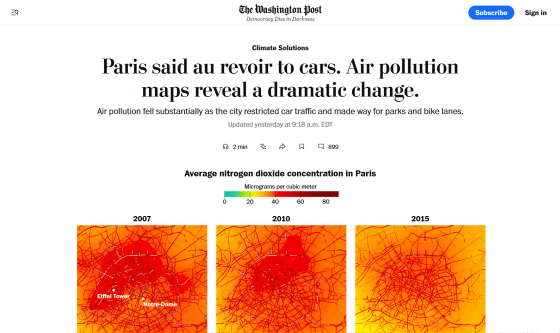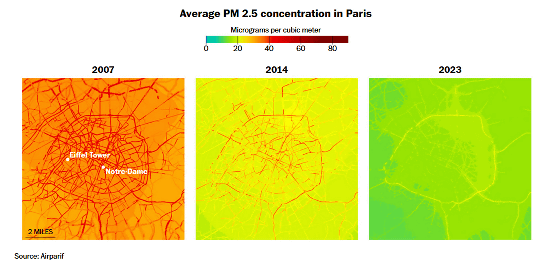By eliminating cars and promoting bicycles, Paris has dramatically improved its air quality.

Air pollution is said to be
La pollution de l'air en baisse en 2024 en Île-de-France, avec encore des impacts importants sur notre santé |
https://www.airparif.fr/actualite/2025/la-pollution-de-lair-en-baisse-en-2024-en-ile-de-france-avec-encore-des-impacts
After Paris curbed cars, air pollution maps reveal a dramatic change - The Washington Post
https://www.washingtonpost.com/climate-solutions/2025/04/12/air-pollution-paris-health-cars/

Under Mayor Anne Hidalgo , who took office in 2014, Paris has implemented reforms to reduce car traffic and promote bicycle use. Large-scale reforms, such as reducing road lanes and replacing them with bicycle lanes, eliminating 50,000 parking spaces, and increasing green spaces, have led to a significant increase in the proportion of bicycle users in Paris.
According to a survey by the Paris Région Institute, an urban planning organization in Paris, 11.2% of trips made in Paris between 2022 and 2023 will be by bicycle, while cars will account for only 4.3%. You can learn more about Mayor Hidalgo's reforms and the increase in bicycle users by reading the following article.
In Paris, where bicycle promotion plans are underway, bicycles are surpassing cars in terms of share of transportation - GIGAZINE

Airparif , an organization that monitors air quality in the Île-de-France region centered on Paris, reported in a report released on April 9, 2025 that the concentration of fine particulate matter (PM2.5) has decreased by 55% and the concentration of nitrogen dioxide ( NO2 ) has decreased by 50% compared to 2005. Both PM2.5 and NO2 are regulated as substances that have a negative impact on health.
The following maps show the average PM2.5 concentration in Paris in 2007, 2014, and 2023, with redder colors indicating higher concentrations. The 2007 map shows the locations of the Eiffel Tower and Notre-Dame Cathedral. The 2007 map shows high PM2.5 concentrations overall, but the PM2.5 concentration gradually decreases, and the 2023 map shows that the PM2.5 concentration is quite low even along the roads in central Paris.

Below are maps showing the average NO2 concentrations in Paris in 2007, 2010, 2015, 2017, 2020, and 2024. As expected, the concentrations are high mainly along major roads, but pollution has been reduced year by year, and by 2024, a wide area was mapped in green.

These big changes show that ambitious policy making can directly improve the health of big cities. Despite opposition to Mayor Hidalgo's proposals, particularly from right-wing politicians, car owners' associations and suburban commuters, Parisians voted in March 2025 to ban cars from an additional 500 roads .
Carlos Moreno , an associate professor at the Sorbonne University in Paris who studies sustainable cities and has served as an adviser to the city of Paris, told the Washington Post that Paris has developed a 'happiness-based urban policy.'